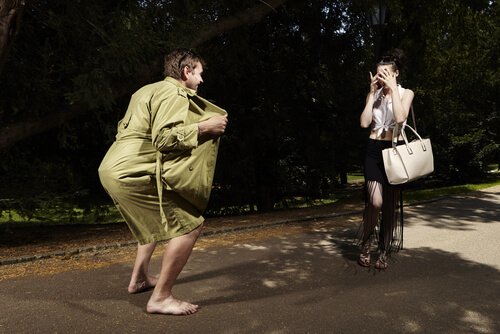Exhibitionism: Causes of This Sexual Paraphilia

The Diagnostic and Statistical Manual of Mental Disorders (DSM) of the American Psychiatric Association includes 8 typical paraphilias and 7 unspecified paraphilias. Among the most common typical paraphilias are fetishism, exhibitionism, voyeurism, pedophilia, and sexual masochism.
However, having an inclination or even an interest consummated in one or more of the categories mentioned above does not, in itself, constitute a clinical syndrome. That is to say, that a person feels a desire or has an intense sexual fantasy towards an atypical sexual object, sensation, or practice does not constitute a problem. What can cause a disorder is when the paraphilia supposes a dysfunction and also causes emotional conflict.
What is exhibitionism?
Exhibitionism is the exposure of one’s genitals to a stranger in order to achieve sexual arousal. This practice includes, in itself, the derivation of the sexual act, since the sensation of pleasure is obtained by showing the genitals to third parties. Most often, the third parties are women or children.
In addition, there’s almost never a subsequent attempt to maintain sexual activity with the stranger on the part of the exhibitionist. This means they rarely commit rape and don’t usually develop a disorder.
On the other hand, the person who practices exhibitionism instead of seeking a sexual encounter represses it. Also, sexual excitement occurs by mentally anticipating the situation, with a sensation similar to that of masturbation.
At this point, it’s important to differentiate exhibition from exhibitionism. The concept of exhibition, unlike exhibitionism which is delimited criminologically and medically, doesn’t imply an attitude of sexual content. It consists purely and exclusively in showing something in public (Ripolles, 1982).

Why do some people enjoy “flashing”?
Exhibitionism usually begins in adolescence. Also, most exhibitionists are married men. However, usually, these marriages are conflictive. Approximately 30% of arrested male sex offenders are exhibitionists. They tend to continue this type of behavior over time and 20-50% are arrested more than once.
The causes of exhibitionism lie in inadequate learning. In this paraphilia, an inappropriate stimulus is usually associated with a strong sexual activation of the individual, which can become a sexually conditioned stimulus at other times. On the other hand, these situations usually occur during adolescence (Muse and Frigola, 2003).
Later experiences of conditioning through fantasies and masturbation would reinforce these sexual responses. Also, there are factors that predispose an individual to exhibitionism, such as difficulties in establishing an interpersonal sexual relationship or lack of self-esteem.
Among the various causes, exhibitionists tend to be timid individuals who have a difficult time forming relationships with women. Thus, in some exhibitionists, the desire and the act occur when they’re experiencing emotional crises, despite showing a normal level of sociocultural intelligence.

On the other hand, they’re not usually dangerous individuals. In addition, they usually don’t abuse their victims. On the contrary, most of them react in an insecure way and run away if their offer is reciprocated. Their desire is to surprise their victims, provoking reactions of fear, and also of disgust or curiosity. In this way, they can experience a sense of dominance. They hate mockery or indifference.
The feeling of exhibitionism is looking at your naked body in the mirror and thinking: “If someone visits me now, I won’t have time to get dressed.”
General criteria and compulsive factors in exhibitionism
According to the DSM, the criteria for the diagnosis of exhibitionist disorder follows two indicators:
- Recurring and highly exciting sexual fantasies, sexual impulses, or behaviors that involve exposing one’s genitals to a stranger who doesn’t expect it for a period of at least six months.
- Fantasies, sexual impulses, or behaviors that cause clinically significant discomfort or social, occupational, or other important activity impairments.
While there aren’t many studies on the subject, doctors believe that the exhibitionist or “flasher” hasn’t been able to overcome certain instances of child sexual development. It could also be said that those who practice exhibitionism suffer from a certain sexual immaturity. While it may be paradoxical, it’s estimated that the exhibitionist suffers from inferiority and self-acceptance or relationship disorders. In addition, they tend to be impulsive and antisocial subjects.
Something that has been studied and validated is that the exhibitionist exposes themselves to strangers due to a strong compulsive desire. They’re also aware of their need to surprise, impact, or impress the observer.
Most people who suffer from this paraphilia have ideas, thoughts, impulses, or images of a persistent nature that they consider intrusive or inappropriate. These things cause anxiety and also significant discomfort. In this regard, this emotional discomfort is what leads the exhibitionist to neutralize these compulsive thoughts by exposing themselves to an unknown person in public.
Sensuality and exhibitionism are two concepts that adolescents and young people confuse. A look and sensual smile are worth more than a thousand below-the-neckline photos.

Treatment of exhibitionism
Psychological treatments for exhibitionists try to redirect pleasure through other, more appropriate, sexual fantasies. Thus, the treatment of exhibitionism usually uses psychotherapeutic interventions based mainly on behavioral and cognitive techniques. Treatment can also include medical treatments based on the use of hormones or certain drugs.
Cognitive-behavioral perspective
The cognitive-behavioral orientation explains the acquisition and maintenance of paraphilias through the paradigms of conditioning and the formation of cognitive schemes (Muse, 1996).
The great majority of paraphilias are manifested during puberty. In this regard, it gives the impression that there may be a window of opportunity by which the conditioning to sexual stimulation is especially conducive during this period of maturation.
Changing these paraphilic behaviors usually requires a multimodal intervention. One that interferes with the previous learning through classical and social conditioning. In addition, it should modify basic schemes of the individual’s cognitive structure (Muse and Frigola, 2003).
Although male hormones are inherently involved in maintaining sexual motivation, learning at a young age determines the direction of sexual interest. Therefore, the use of chemical substances in the treatment of paraphilias is usually reserved as an adjunct therapy to psychotherapy (Muse and Frigola, 2003).
Thus, psychological therapy is the only way to help those who suffer from this disorder. While it’s unfeasible to eliminate the desire of the exhibition, therapy can make the desire functional. Working on the compulsive and disruptive act, as well as on the guilt that usually awakens this sexual impulse.
Discreteness is important in relation to the exhibitionist. Because they will be sober in relation to the arrogant, convinced in relation to the insecure. Generous in relation to the selfish, hardworking in relation to the comfortable, and committed in relation to the distant.
Bibliography
Arteaga Vera, R. B. (2014). Tipificar la penalización de conductas delictivas que identifican las parafilias criminales, dentro del capítulo ii, del título viii, del libro ii, del código penal del ecuador (Bachelor’s thesis).
De Dios Blanco, E. (2007). Las parafilias: De Krafft Ebing a Kafka.
Diez Ripolles, J. L. (1982). Exhibicionismo, pornografía y otras conductas sexuales provocadoras: La frontera del derecho penal sexual.
Gamboa, I. (2006). La constitucion de trastornos sexuales en la Psiquiatria. Diálogos Revista Electrónica de Historia, 7(1).
Giordano, E. (2004). Apuntes para una crítica de los medios interactivos. De la degradación cultural al exhibicionismo tecnológico. Revista Iberoamericana de Educación, 36, 69-88.
Herrera, J. L. (2014). Una mirada a” La tupida copa de un árbol,” de Julieta García González: entre el voyeurismo, la pareidolia y el exhibicionismo. Romance Notes, 54(4), 131-141.
Jiménez, C. G. T. Seminario Temático: Parafilias.
Manual diagnóstico y estadístico de los trastornos mentales: DSM-5. Editorial medica panamericana, 2014.
Marshall, W. L., & Fernandez, Y. M. (1997). Enfoques cognitivo-conductuales para las parafilias: el tratamiento de la delincuencia sexual. Manual para el tratamiento cognitivo-conductual de los trastornos psicológicos, 1, 299-331.
Molina de la Cueva, M. F. (2017). Anteproyecto de ley reformatoria al artículo 175 del código orgánico integral penal, que establece la obligatoriedad de tratar psiquiátricamente a los agresores sexuales.
Muse, M., & Frigola, G. (2003). La evaluación y tratamiento de trastornos parafílicos. Cuadernos de Medicina Psicosomática y Psiquiatría de Enlace, 65, 55-72.
Romi, J. C. (2008). Las perturbaciones sexuales. Críticas a su inclusión como trastornos mentales en el DSM IV-TR. Revista de Psiquiatría Forense, Sexología y Praxis, 6(1), 24-49.
The Diagnostic and Statistical Manual of Mental Disorders (DSM) of the American Psychiatric Association includes 8 typical paraphilias and 7 unspecified paraphilias. Among the most common typical paraphilias are fetishism, exhibitionism, voyeurism, pedophilia, and sexual masochism.
However, having an inclination or even an interest consummated in one or more of the categories mentioned above does not, in itself, constitute a clinical syndrome. That is to say, that a person feels a desire or has an intense sexual fantasy towards an atypical sexual object, sensation, or practice does not constitute a problem. What can cause a disorder is when the paraphilia supposes a dysfunction and also causes emotional conflict.
What is exhibitionism?
Exhibitionism is the exposure of one’s genitals to a stranger in order to achieve sexual arousal. This practice includes, in itself, the derivation of the sexual act, since the sensation of pleasure is obtained by showing the genitals to third parties. Most often, the third parties are women or children.
In addition, there’s almost never a subsequent attempt to maintain sexual activity with the stranger on the part of the exhibitionist. This means they rarely commit rape and don’t usually develop a disorder.
On the other hand, the person who practices exhibitionism instead of seeking a sexual encounter represses it. Also, sexual excitement occurs by mentally anticipating the situation, with a sensation similar to that of masturbation.
At this point, it’s important to differentiate exhibition from exhibitionism. The concept of exhibition, unlike exhibitionism which is delimited criminologically and medically, doesn’t imply an attitude of sexual content. It consists purely and exclusively in showing something in public (Ripolles, 1982).

Why do some people enjoy “flashing”?
Exhibitionism usually begins in adolescence. Also, most exhibitionists are married men. However, usually, these marriages are conflictive. Approximately 30% of arrested male sex offenders are exhibitionists. They tend to continue this type of behavior over time and 20-50% are arrested more than once.
The causes of exhibitionism lie in inadequate learning. In this paraphilia, an inappropriate stimulus is usually associated with a strong sexual activation of the individual, which can become a sexually conditioned stimulus at other times. On the other hand, these situations usually occur during adolescence (Muse and Frigola, 2003).
Later experiences of conditioning through fantasies and masturbation would reinforce these sexual responses. Also, there are factors that predispose an individual to exhibitionism, such as difficulties in establishing an interpersonal sexual relationship or lack of self-esteem.
Among the various causes, exhibitionists tend to be timid individuals who have a difficult time forming relationships with women. Thus, in some exhibitionists, the desire and the act occur when they’re experiencing emotional crises, despite showing a normal level of sociocultural intelligence.

On the other hand, they’re not usually dangerous individuals. In addition, they usually don’t abuse their victims. On the contrary, most of them react in an insecure way and run away if their offer is reciprocated. Their desire is to surprise their victims, provoking reactions of fear, and also of disgust or curiosity. In this way, they can experience a sense of dominance. They hate mockery or indifference.
The feeling of exhibitionism is looking at your naked body in the mirror and thinking: “If someone visits me now, I won’t have time to get dressed.”
General criteria and compulsive factors in exhibitionism
According to the DSM, the criteria for the diagnosis of exhibitionist disorder follows two indicators:
- Recurring and highly exciting sexual fantasies, sexual impulses, or behaviors that involve exposing one’s genitals to a stranger who doesn’t expect it for a period of at least six months.
- Fantasies, sexual impulses, or behaviors that cause clinically significant discomfort or social, occupational, or other important activity impairments.
While there aren’t many studies on the subject, doctors believe that the exhibitionist or “flasher” hasn’t been able to overcome certain instances of child sexual development. It could also be said that those who practice exhibitionism suffer from a certain sexual immaturity. While it may be paradoxical, it’s estimated that the exhibitionist suffers from inferiority and self-acceptance or relationship disorders. In addition, they tend to be impulsive and antisocial subjects.
Something that has been studied and validated is that the exhibitionist exposes themselves to strangers due to a strong compulsive desire. They’re also aware of their need to surprise, impact, or impress the observer.
Most people who suffer from this paraphilia have ideas, thoughts, impulses, or images of a persistent nature that they consider intrusive or inappropriate. These things cause anxiety and also significant discomfort. In this regard, this emotional discomfort is what leads the exhibitionist to neutralize these compulsive thoughts by exposing themselves to an unknown person in public.
Sensuality and exhibitionism are two concepts that adolescents and young people confuse. A look and sensual smile are worth more than a thousand below-the-neckline photos.

Treatment of exhibitionism
Psychological treatments for exhibitionists try to redirect pleasure through other, more appropriate, sexual fantasies. Thus, the treatment of exhibitionism usually uses psychotherapeutic interventions based mainly on behavioral and cognitive techniques. Treatment can also include medical treatments based on the use of hormones or certain drugs.
Cognitive-behavioral perspective
The cognitive-behavioral orientation explains the acquisition and maintenance of paraphilias through the paradigms of conditioning and the formation of cognitive schemes (Muse, 1996).
The great majority of paraphilias are manifested during puberty. In this regard, it gives the impression that there may be a window of opportunity by which the conditioning to sexual stimulation is especially conducive during this period of maturation.
Changing these paraphilic behaviors usually requires a multimodal intervention. One that interferes with the previous learning through classical and social conditioning. In addition, it should modify basic schemes of the individual’s cognitive structure (Muse and Frigola, 2003).
Although male hormones are inherently involved in maintaining sexual motivation, learning at a young age determines the direction of sexual interest. Therefore, the use of chemical substances in the treatment of paraphilias is usually reserved as an adjunct therapy to psychotherapy (Muse and Frigola, 2003).
Thus, psychological therapy is the only way to help those who suffer from this disorder. While it’s unfeasible to eliminate the desire of the exhibition, therapy can make the desire functional. Working on the compulsive and disruptive act, as well as on the guilt that usually awakens this sexual impulse.
Discreteness is important in relation to the exhibitionist. Because they will be sober in relation to the arrogant, convinced in relation to the insecure. Generous in relation to the selfish, hardworking in relation to the comfortable, and committed in relation to the distant.
Bibliography
Arteaga Vera, R. B. (2014). Tipificar la penalización de conductas delictivas que identifican las parafilias criminales, dentro del capítulo ii, del título viii, del libro ii, del código penal del ecuador (Bachelor’s thesis).
De Dios Blanco, E. (2007). Las parafilias: De Krafft Ebing a Kafka.
Diez Ripolles, J. L. (1982). Exhibicionismo, pornografía y otras conductas sexuales provocadoras: La frontera del derecho penal sexual.
Gamboa, I. (2006). La constitucion de trastornos sexuales en la Psiquiatria. Diálogos Revista Electrónica de Historia, 7(1).
Giordano, E. (2004). Apuntes para una crítica de los medios interactivos. De la degradación cultural al exhibicionismo tecnológico. Revista Iberoamericana de Educación, 36, 69-88.
Herrera, J. L. (2014). Una mirada a” La tupida copa de un árbol,” de Julieta García González: entre el voyeurismo, la pareidolia y el exhibicionismo. Romance Notes, 54(4), 131-141.
Jiménez, C. G. T. Seminario Temático: Parafilias.
Manual diagnóstico y estadístico de los trastornos mentales: DSM-5. Editorial medica panamericana, 2014.
Marshall, W. L., & Fernandez, Y. M. (1997). Enfoques cognitivo-conductuales para las parafilias: el tratamiento de la delincuencia sexual. Manual para el tratamiento cognitivo-conductual de los trastornos psicológicos, 1, 299-331.
Molina de la Cueva, M. F. (2017). Anteproyecto de ley reformatoria al artículo 175 del código orgánico integral penal, que establece la obligatoriedad de tratar psiquiátricamente a los agresores sexuales.
Muse, M., & Frigola, G. (2003). La evaluación y tratamiento de trastornos parafílicos. Cuadernos de Medicina Psicosomática y Psiquiatría de Enlace, 65, 55-72.
Romi, J. C. (2008). Las perturbaciones sexuales. Críticas a su inclusión como trastornos mentales en el DSM IV-TR. Revista de Psiquiatría Forense, Sexología y Praxis, 6(1), 24-49.
This text is provided for informational purposes only and does not replace consultation with a professional. If in doubt, consult your specialist.







